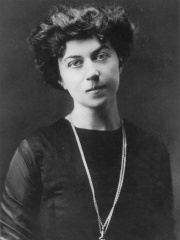
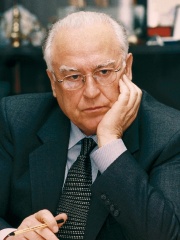
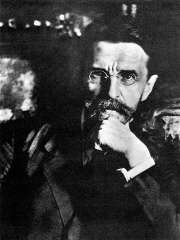
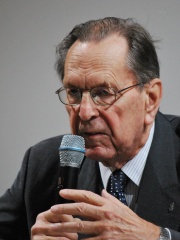
The Most Famous
DIPLOMATS from Russia
Top 5
The following people are considered by Pantheon to be the most legendary Russian Diplomats of all time. This list of famous Russian Diplomats is sorted by HPI (Historical Popularity Index), a metric that aggregates information on a biography's online popularity.

1. Alexandra Kollontai (1872 - 1952)
With an HPI of 76.62, Alexandra Kollontai is the most famous Russian Diplomat. Her biography has been translated into 70 different languages on wikipedia.
Alexandra Mikhailovna Kollontai (Russian: Александра Михайловна Коллонтай; née Domontovich, Домонтович; 31 March [O.S. 19 March] 1872 – 9 March 1952) was a Russian revolutionary, politician, diplomat and Marxist theoretician. Serving as the People's Commissar for Welfare in Vladimir Lenin's government in 1917–1918, she was a highly prominent woman within the Bolshevik party. She was the first woman in history to be a cabinet minister, and one of the first women to be appointed as a diplomatic representative of a modern state, and the first to be promoted to the rank of ambassador. The daughter of an Imperial Russian Army general, Kollontai embraced radical politics in the 1890s and joined the Russian Social Democratic Labour Party (RSDLP) in 1899. During the RSDLP ideological split, she sided with Julius Martov's Mensheviks against Lenin's Bolsheviks. Exiled from Russia in 1908, Kollontai toured Western Europe and the United States and campaigned against participation in the First World War. In 1915, she broke with the Mensheviks and became a member of the Bolsheviks. Following the 1917 February Revolution which ousted the tsar, Kollontai returned to Russia. She supported Lenin's radical proposals and, as a member of the party's Central Committee, voted for the policy of armed uprising which led to the October Revolution and the fall of Alexander Kerensky's Provisional Government. She was appointed People's Commissar for Social Welfare in the first Soviet government, but soon resigned due to her opposition to the peace treaty of Brest-Litovsk in the ranks of the Left Communists. In 1919, Kollontai was a leading figure in the foundation of the Zhenotdel, the then-new women's department of the Central Committee that was aimed at improving the status of women in the Soviet Union. She was a champion of women's liberation, and later came to be recognized as a key figure in Marxist feminism. Kollontai was outspoken against bureaucratic influences over the Communist Party and its undemocratic internal practices. To that end, she sided with the left-wing Workers' Opposition in 1920, but was eventually defeated and sidelined, narrowly avoiding her own expulsion from the party altogether. From 1922 on, she was appointed to various diplomatic posts abroad, serving in Norway, Mexico and Sweden. In 1943, she was promoted to the title of ambassador to Sweden. Kollontai retired from diplomatic service in 1945 and died in Moscow in 1952.

2. Viktor Chernomyrdin (1938 - 2010)
With an HPI of 69.56, Viktor Chernomyrdin is the 2nd most famous Russian Diplomat. His biography has been translated into 63 different languages.
Viktor Stepanovich Chernomyrdin (Russian: Ви́ктор Степа́нович Черномы́рдин, IPA: [ˈvʲiktər sʲtʲɪˈpanəvʲɪtɕ tɕɪrnɐˈmɨrdʲɪn]; 9 April 1938 – 3 November 2010) was a Soviet and Russian politician and businessman. He was the Minister of Gas Industry of the Soviet Union (13 February 1985 – 17 July 1989), after which he became first chairman of Gazprom energy company and the second-longest-serving Prime Minister of Russia (1992–1998) based on consecutive years. He was a key figure in Russian politics in the 1990s and a participant in the transition from a planned to a market economy. From 2001 to 2009, he was Russia's ambassador to Ukraine. After that, he was designated as a presidential adviser. Chernomyrdin was known in Russia and Russian-speaking countries for his language style, which contained numerous malapropisms and syntactic errors. Many of his sayings became aphorisms and idioms in the Russian language, two examples being the expression "We wanted the best, but it turned out like always." (Russian: Хотели как лучше, а получилось как всегда) and "The thing that never happens just happened again" (Russian: Никогда такого не было, и вот опять). Chernomyrdin died on 3 November 2010 after a long illness. He was buried beside his wife in Novodevichy Cemetery on 5 November, and his funeral was broadcast live on Russian federal TV channels.

3. Vatslav Vorovsky (1871 - 1923)
With an HPI of 57.70, Vatslav Vorovsky is the 3rd most famous Russian Diplomat. His biography has been translated into 18 different languages.
Vatslav Vatslavovich Vorovsky (Russian: Ва́цлав Ва́цлавович Воро́вский; 27 October [O.S. 15 October] 1871 – 10 May 1923) was a Russian Bolshevik revolutionary, literary critic, journalist, and Soviet diplomat. One of the first Soviet diplomats, Vorovsky is best remembered as the victim of a May 1923 political assassination in Switzerland, where he was the official representative of the Soviet government to the Conference of Lausanne.

4. Max Jakobson (1923 - 2013)
With an HPI of 55.11, Max Jakobson is the 4th most famous Russian Diplomat. His biography has been translated into 19 different languages.
Max Jakobson (September 30, 1923 – March 9, 2013) was a Finnish diplomat and journalist of Finnish-Jewish descent. Jakobson was an instrumental figure in shaping Finland's policy of neutrality during the Cold War. Max Jakobson was born in 1923 in Viipuri, Finland (now Vyborg, Russia), as son of Finnish-Jewish lawyer Jonas Jakobson and his ethnic Finnish wife Helmi (née Virtanen). He began his career as a journalist. He worked at the BBC. From 1953 to 1974 he was employed by the Finnish Ministry for Foreign Affairs eventually acting as Finland's ambassador to the United Nations in 1965-1971 and Finland's Ambassador to Sweden in 1971−1974. Jakobson ran for United Nations Secretary-General in the 1971 selection. He was one of three candidates to receive the required 9 votes in the Security Council, but he was vetoed by the Soviet Union. Jakobson was active as a commentator on Finnish politics, having written several books and numerous articles on Finnish political history and contemporary Finnish politics. He also acted as chairman of the Estonian International Commission for Investigation of Crimes Against Humanity investigating Communist and Nazi crimes in Estonia.
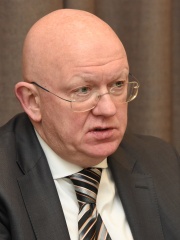
5. Vasily Nebenzya (b. 1962)
With an HPI of 53.01, Vasily Nebenzya is the 5th most famous Russian Diplomat. His biography has been translated into 18 different languages.
Vasily Alekseyevich Nebenzya (Russian: Василий Алексеевич Небензя; born 26 February 1962) is a Russian diplomat and the current Permanent Representative of Russia to the United Nations. His official title is Ambassador Extraordinary and Plenipotentiary.
People
Pantheon has 5 people classified as Russian diplomats born between 1871 and 1962. Of these 5, 1 (20.00%) of them are still alive today. The most famous living Russian diplomats include Vasily Nebenzya. The most famous deceased Russian diplomats include Alexandra Kollontai, Viktor Chernomyrdin, and Vatslav Vorovsky.
Living Russian Diplomats
Go to all RankingsDeceased Russian Diplomats
Go to all RankingsAlexandra Kollontai
1872 - 1952
HPI: 76.62
Viktor Chernomyrdin
1938 - 2010
HPI: 69.56
Vatslav Vorovsky
1871 - 1923
HPI: 57.70
Max Jakobson
1923 - 2013
HPI: 55.11
Overlapping Lives
Which Diplomats were alive at the same time? This visualization shows the lifespans of the 4 most globally memorable Diplomats since 1700.

